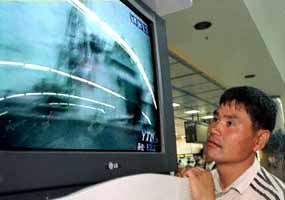| . |  |
. |
Redondo Beach - October 12, 1999 - Team ABL which brings together the US Air Force, Boeing, TRW and Lockheed Martin - has completed testing of the TRW-developed laser module that will serve as the technical foundation for America's Airborne Laser (ABL) missile defense system. During a four-month long test program at TRW's Capistrano Test Site in Southern California, the flight weighted laser module-3 (FLM-3) exceeded by a significant margin the laser power and beam quality requirements of the operational ABL system, according to Col. Mike Booen, director of the Air Force's ABL program. Caption:A TRW technician prepares the TRW-developed flight weighted laser module-3 (FLM-3) to test the module's output power or beam quality. The testing demonstrated that the FLM-3, a multi-hundred kilowatt class chemical oxygen iodine laser (COIL) meets the size, weight, and performance requirements for the operational ABL system. Output power and beam quality are a measure of the laser's ability to put "energy on target" to destroy a boosting theater ballistic missile. The test program was completed on August 26. "Team ABL's success in defining and bringing the next generation ABL laser module on line in less than a year is a testament to the robust test program and maturity of the laser technology underpinning the ABL weapon system development. "The FLM-3 test results provide the latest evidence from our extensive ABL test program that the system design is solid and that we're on course to put this revolutionary weapon system in the air in 2003." said Booen.
 Caption:The test program is part of an on-going effort by Team ABL to optimize the module performance in support of creating a detailed design for the first ABL flight version laser module that will see a test environment similar to the above image. Fabrication of that first flight version hardware is scheduled to begin in early 2000. According to Steve Toner, TRW's ABL program manager, the success with the FLM-3 stems largely from improvements that TRW made in the design of the components that regulate the flow and recirculation of chemical reactants through the laser. These hardware changes incorporate "lessons learned" from the extensive FLM test program conducted throughout the summer of 1998. "We tested the FLM-3 under its full operating range - from conditions representing its first shot from a 'fresh' chemical magazine to conditions representing its last shot from a 'spent' magazine. "Under all test scenarios the laser produced sufficient power to exceed by a significant margin the range requirements of an operational ABL system. We now know with certainty that our module design contains sufficient laser reactants to meet the ABL mission requirements while staying within the weight budget for the first ABL system," explained Toner. The other significant characteristic of the test program, added Toner, was that TRW made all the critical FLM-3 power and beam quality measurements under hot, high pressure cavity conditions representative of actual ABL laser operating conditions. "We made every effort to make these tests as realistic as possible," he said, "because we're using the test results to 'freeze' our design." Completion of the FLM-3 testing paves the way for Team ABL to finalize the design of the flight laser modules and begin manufacturing the first of six modules required for the first 747-based ABL system. Manufacturing of that first module is slated to begin early next year. Testing of the first flight laser module is scheduled for late next year. The ABL weapon system will use a megawatt-class chemical oxygen iodine laser (COIL) mounted on a modified 747-400F freighter aircraft to shoot down theater ballistic missiles in their boost phase. It is the Department of Defense's choice for the boost phase intercept element of its theater missile defense architecture. ABL will protect civilian and key military assets from attack by missiles such as the Scuds used by Iraq during the Persian Gulf War. Team ABL is in the third year of a $1.4 billion program definition and risk reduction contract with the Air Force Space & Missile Systems Center to design, produce, integrate and flight test the first prototype ABL demonstration system. The contract is scheduled to culminate in 2003 with a boost-phase shoot-down of a theater ballistic missile. The ABL engineering and manufacturing development (EMD) program is scheduled to begin in 2004. The FLM-3 test program was conducted as part of Team ABL's current program definition and risk reduction (PDRR) contract with the Air Force Space & Missile Systems Center, Kirtland AFB, New Mexico.
Feedback request We are adding more images to some of our reports and changing the end of page design. The file size is climbing, and we would be grateful for any feedback on downloading problems. If it's too much we will scale back the use of images. Sorry the ads have to stay.
Related Links
 Seoul (AFP) October 12, 1999 -
Seoul (AFP) October 12, 1999 - North Korea officially launched a seven-hour daily satellite television broadcast beginning October 10, Pyongyang's official Korean Central News Agency (KCNA) said on Tuesday. |
|
|
|
|
|
|
|
|
|
|
|
|
|
| The content herein, unless otherwise known to be public domain, are Copyright 1995-2006 - SpaceDaily.AFP and UPI Wire Stories are copyright Agence France-Presse and United Press International. ESA PortalReports are copyright European Space Agency. All NASA sourced material is public domain. Additionalcopyrights may apply in whole or part to other bona fide parties. Advertising does not imply endorsement,agreement or approval of any opinions, statements or information provided by SpaceDaily on any Web page published or hosted by SpaceDaily. Privacy Statement |